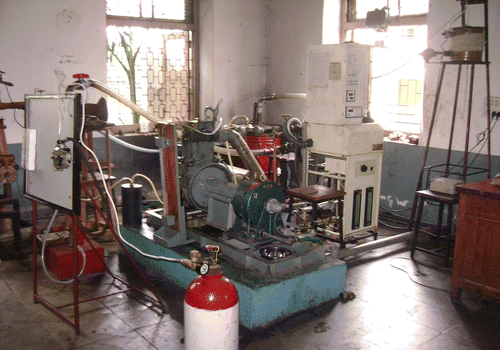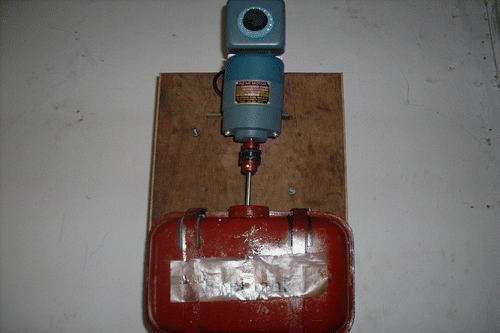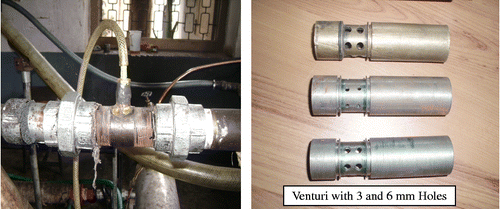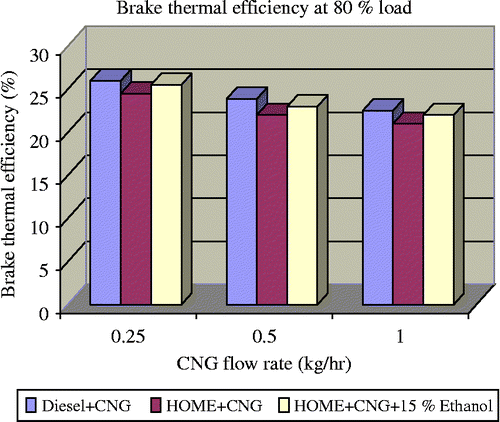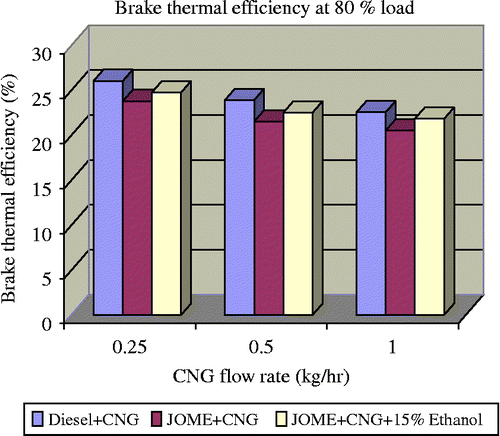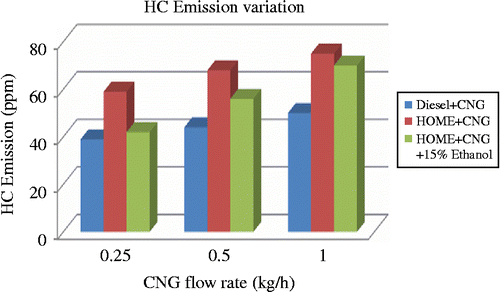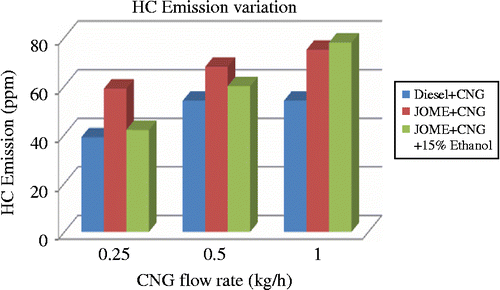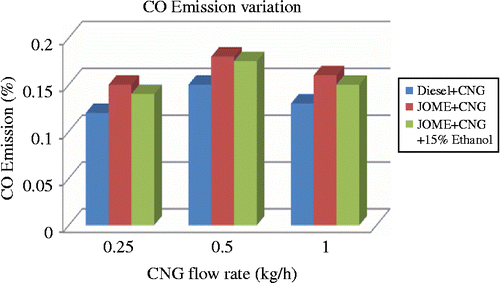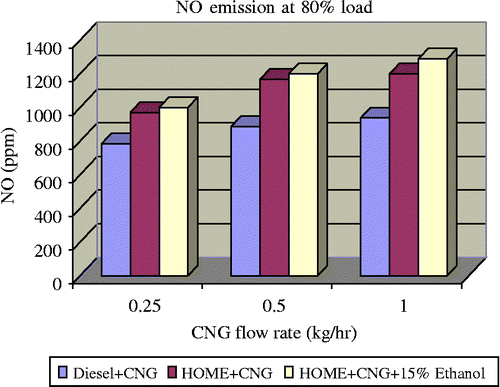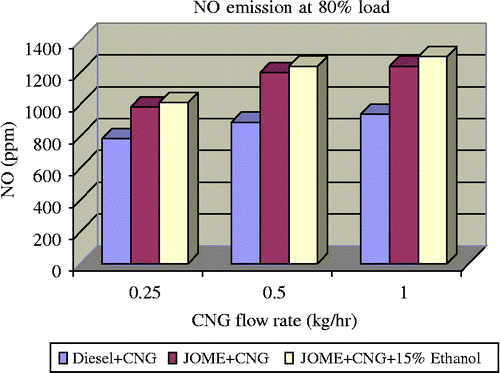Abstract
The demand for petroleum products in India has been increasing at a rate higher than the increase of domestic availability. At the same time, there is continuous pressure on emission control through periodically tightened regulations particularly in metropolitan cities. In the wake of this situation, there is an urgent need to promote the use of alternative fuels as substitutes for high-speed diesel. Dual-fuel mode of operation employing compressed natural gas (CNG) and plant oils such as Honge and Jatropha oils and their esters is an attractive option as our country has a large agriculture base that can be a feedstock to this fuel technology which can ease the burden on the economy by curtailing fuel imports. This paper presents the results of investigations carried out in studying the behaviour of Honge and Jatropha oil methyl esters and their blends with 15% ethanol and subsequent testing of these oils in a four-stroke, single-cylinder, water-cooled, direct-injection compression ignition engine in dual-fuel mode with CNG induction.
1. Introduction
The use of alternative gaseous fuels in diesel engines is increasing worldwide. The use of gaseous fuels is prompted by the cleaner nature of their combustion compared with conventional liquid fuels as well as by their relatively increased availability at attractive prices. Natural gas has high octane number and, therefore, is suitable for engines with relatively high compression ratio (Papagiannakis and Hountalas Citation2003). In general, gas is used in spark ignition engines because of its relatively higher octane level. However, the compression ratio of this type of engine cannot be as high as that of diesel engine because of the occurrence of knocking. To overcome this disadvantage, dual-fuel combustion system that utilises combined diesel/biodiesel and natural gas fuel has been proposed in recent years (Karim and Burn Citation1980; Kusaka et al. Citation2000; Papagiannakis and Hountalas Citation2004; Nwafor Citation2007). There is continuous pressure on emission control through periodically tightened regulations, particularly for metropolitan cities. To address this situation, there is an urgent need to promote the use of alternative fuels as substitutes for high-speed diesel (Banapurmath et al. Citation2005). Compressed natural gas (CNG) is increasingly being used as a vehicular fuel in metropolitan cities such as Delhi, Kanpur and Mumbai. The problematic traffic-related pollutants such as particulates, ozone precursors and benzene, in particular, are significantly lower than those of diesel, gasoline or LPG engines. CNG is the cheapest automotive fuel available today. Further growth in the consumption of petroleum products will result in increased inflation and consequently would slow down the country economy (Banapurmath et al. Citation2005; Banapurmath et al. Citation2007).
In a dual-fuel engine, a mixture of natural gas and air is induced in the engine cylinder and is compressed during compression stroke. This air–fuel mixture is ignited by injecting a small quantity of diesel or non-edible oil, called as pilot injection, into the cylinder at the end of compression stroke (Nwafor Citation2007; Selim et al. Citation2008).
This diesel or non-edible oil pilot fuel ignites due to heat of compression, just like in diesel engine. Burning of diesel or non-edible oil pilot fuel further ignites and burns the compressed natural gas in the cylinder, producing power (Balasubramanian et al. Citation1995; Sayin et al. Citation2008).
In this context, the experimental investigations were carried out on a single-cylinder, four-stroke, water-cooled, direct-injection (DI) diesel engine, developing a power output of 5.2 kW at 1500 rpm in dual-fuel mode with various fuel combinations of Honge and Jatropha oil methyl esters (HOME/JOME) and their blends with ethanol as injected fuel along with CNG as the inducted fuel. Various methods of employing ethanol–diesel/biodiesel dual-fuel operation have been developed to enhance the engine performance with lowered emissions (Likos et al. Citation1982; Shropshire and Goering Citation1982; Meiring et al. Citation1983).
2. Fuel properties
The important properties of HOME/JOME as well as the ethanol–biodiesel blends used and CNG are found by standard methods and compared with those of diesel. The results show that the heating value of vegetable oil is comparable to that of diesel oil, but it is slightly lower than that of diesel oil. However, kinematic viscosity of neat vegetable oil is several times higher than that of diesel oil, and the transesterified oils of Honge and Jatropha show considerable reduced viscosities (Kusaka et al. Citation2000). The various properties of diesel and vegetable oils are shown in Table . Table shows properties of natural gas.
Table 1 Properties of diesel, Honge (karanja) oil, Jatropha oil and their respective esters and biodiesel–ethanol blends (Banapurmath and Tewari 2010).
Table 2 Properties of natural gas.
3. Experimental set-up
Figure shows the overall view of a compression ignition (CI) engine test rig with dual-fuel arrangement. Engine tests were conducted on a four-stroke, single-cylinder, water-cooled, DI CI engine. The specifications of the engine are given in Table . Experiments were conducted on the engine with injection timing of 23° BTDC (before top dead centre) and the actual needle lifting opening pressure of 205bar at 80% loads and at a constant rated speed of 1500 rpm. Figure shows fuel tank with mechanical stirrer and its position in the set-up to mix biodiesel–ethanol blends.
Table 3 Specifications of the engine.
There was no special arrangement to control the engine speed; the regular governor of the engine was used to control the engine speed. The engine was provided with a hemispherical combustion chamber with overhead valves operated through push rods. Cooling of the engine was accomplished by circulating water through the jackets of the engine block and cylinder head. Experiments were conducted under a thermal steady-state condition of the engine with an inlet cooling water temperature of 80°C. A piezoelectric pressure transducer was mounted flush with the cylinder head surface to measure the cylinder pressure. Exhaust gas opacity was measured using the Hartridge smoke opacity meter. The exhaust gas composition was measured using an exhaust gas analyser (Make: MRU, Model: DELTA 1600S). The measured emissions include CO2, carbon monoxide (CO), hydrocarbon (HC), NO x and O2. The basic principle for measurement of CO2, CO, HC and nitrogen oxide (NO) emissions is non-dispersive infrared technology and that for NO x and oxygen measurement is electrochemical method. Tables and show the specifications of the exhaust gas analyser and smoke meter with measurement accuracies and uncertainties.
Table 4 Specifications of exhaust gas analyser.
Table 5 Specifications of smoke meter.
4. Results and discussion
4.1 Performance characteristics
This section presents the results of investigation carried out on a single cylinder, DI engine operating on diesel, HOME, JOME and their optimised 15% blends with ethanol together with CNG in dual-fuel mode of operation. Engine tests were done with the aim of obtaining comparative measures of brake thermal efficiency (BTE), brake-specific fuel consumption, torque, brake power and smoke density.
4.2 Brake thermal efficiency
The magnitude of engine de-rating is observed to be 20%. Figures and show the variation of BTE for diesel–CNG, HOME–CNG, JOME–CNG dual-fuel combinations at 80% load. The BTE is found to be higher for CNG–diesel dual-fuel mode of operation than that for HOME–CNG and JOME–CNG modes of operation at 80% load. CNG being common, properties of the injected fuels have a major effect on the engine performance. The injected biodiesel fuels have higher viscosity than diesel which makes atomisation difficult and also have lower calorific value, which together result in lower BTE. The BTE improved with HOME–CNG–15% ethanol and JOME–CNG–15% ethanol at the same operating condition of injection pressure and injection timing. The reason could be that the quality of the spray obtained with blended fuels improves due to lower boiling point of ethanol than that of HOME/JOME–CNG combination. The combustion is more complete in the fuel-rich zone due to the oxygen present in ethanol-blended fuels. This results in enhanced combustion efficiency and decreased heat losses in the cylinder due to lower flame temperature of ethanol-blended CNG fuels than that of plain biodiesel of HOME/JOME–CNG dual-fuel operation. All the dual-fuel combinations show decreased BTE with increase in the gas flow rate. This is mainly due to lower pilot fuel quantity being injected with increased gas flow rate.
4.3 Emission characteristics
4.3.1 Smoke opacity
Figures and show the variation of smoke opacity for diesel–CNG, HOME—CNG and JOME–CNG dual-fuel combinations at 80% load. CNG–diesel dual-fuel operation shows lower smoke opacity than HOME–CNG at 80% load. The heavier molecular structure of the injected biodiesel fuels compared to diesel results in higher smoke levels. The smoke opacity decreased with blends of Honge–ethanol–CNG dual-fuel operation. This is because the presence of bonded oxygen reduces the probability of soot nuclei formation in locally rich zones. The enrichment of oxygen content in the fuel due to the addition of oxygenates by both methyl ester of Honge oil and ethanol results in more complete combustion. Increasing the CNG quantity increases the quantity of heat output and the maximum temperature in the cylinder. For low gaseous flow rates, the charge temperature is inferior (Papagiannakis and Hountalas 2003). This results in better combustion and so the smoke opacity reduces with increased CNG quantity (Papagiannakis and Hountalas 2003; Zhen-tao and Shao-mei Citation2004). At higher gas flow rates, the higher gas temperature promotes soot oxidation rate contributing to a further decrease of soot concentration (Papagiannakis and Hountalas 2003).
4.3.2 HC emissions
HC emissions shown in Figures and were higher throughout the load range for the injected biodiesel–CNG dual-fuel combinations than those for CNG–diesel. The HC emissions were reduced with the HOME/JOME/15% ethanol–CNG dual-fuel combinations because of the complete combustion of ethanol. When ethanol is added to the diesel/biodiesel fuel, it can provide more oxygen for the combustion process and can lead to improved combustion.
At higher engine load, there is an increase of HC emissions with increasing gaseous fuel rates until a certain limit from where they start to decrease. This is due to the increase in burnt gas temperature, which promotes the oxidation of unburned HC. Under dual-fuel operation, the filling of the crevice volumes with unburned mixture of air and gaseous fuel during compression and combustion, while the cylinder pressure continues to rise, is an important source dominating the formation of HC emissions (Papagiannakis and Hountalas Citation2003; Zhen-tao and Shao-mei Citation2004).
4.3.3 CO emissions
The exhaust emissions of CO (Figures and ) were lower for CNG–diesel dual-fuel operations than those for HOME/JOME–CNG, respectively. This may be due to higher heat release during the premixed burning phase rather than the diffusion burning phase with CNG–diesel mixture. Emissions of CO are greatly dependent on the air–fuel ratio relative to stoichiometric proportions. Rich combustion invariably produces CO, and emissions increase linearly with the deviation from the stoichiometry. The CO emission is lower for HOME/JOME ethanol–CNG dual-fuel operation. This is the result of improving combustion process because oxygen content in the ethanol causes better combustion.
At high engine load, CO emissions increase with increasing CNG flow rate, and beyond a certain value of gaseous fuel they start to decrease, as a result of the high gas temperature and faster combustion rate (Papagiannakis and Hountalas Citation2003). At extremely low CNG fuel injection, exhaust emissions of CO and fraction of gas consumed are very small. Furthermore, increased injection of CNG increases CO emission, and later on these begin to decrease (Badr et al. Citation1999).
Increasing the CNG quantity increases the quantity of heat output and thus the maximum temperature in the cylinder. Therefore, the combustion process completes adequately and so CO emissions reduce with increased CNG quantity (Zhen-tao and Shao-mei Citation2004). Figures and substantiate this statement and the CO emission is observed to be lowest at 1 kg/h CNG gas flow rate. As the gas flow rate increases beyond 1 kg/h, engine knock will occur resulting in poor engine performance. The onset of knock is only encountered at high compression ratios for CNG operation (Li and Karim Citation2006).
4.3.4 NO emissions
NO emissions in dual-fuel mode (Figures and ) do not vary significantly with the change in injected fuel. NO x emissions were lower for CNG–diesel dual-fuel operation. Higher NO x emissions for injected vegetable oils in dual-fuel operation may be due to the availability of higher oxygen that is present in the injected vegetable oil's molecular structure. Also for the same power output, more vegetable oils are required (due to increased specific fuel consumption), leading to delayed injection. For HOME/JOME–ethanol blends–CNG combinations, the exhaust gas temperature increases. This high-peak temperature increases NO x emissions. Also the oxygenate of ethanol–ester fuel combinations in CNG results in higher NO x emissions than the ester alone due to more complete combustion. All the dual-fuel combinations show increased NO x emissions with increase in the gas flow rate. This is mainly due to the increased quantity of heat output and the maximum temperature prevailing inside the engine cylinder with increased gas flow rate. Therefore, the combustion process completed adequately results in increased NO x emission (Zhen-tao and Shao-mei Citation2004).
5. Flame propogation in gas–air mixture
The equivalence ratio may influence the start of significant local partial oxidation, the flame initiation and the spread of propagating flames within CNG–air charge, respectively. The complex chemical and physical interactions that take place to produce these regions require the consideration of a number of related processes. These would include pre-ignition reaction activity of the CNG–air mixture during compression, the pilot [diesel/biodiesel] injection processes and subsequent formation of the flammable envelope, and progressive reactions during the ignition delay of the liquid fuel. Formation of ignition centres provided by injected fuels and subsequent reactions with the CNG–air mixture may lead to partial or complete flame propagation (Badr et al. Citation1999).
6. Conclusion
The biodiesel–CNG fuel combinations result in lower BTE and increased emissions of smoke, HC, CO than diesel–CNG dual-fuel operation. With ethanol addition and HOME/JOME–CNG dual-fuel operation, the performance improved in terms of increased BTE, reduced smoke, HC and CO emissions when compared with that of CNG and HOME/JOME dual-fuel operation. However, NO emission increased. The addition of 15% ethanol to biodiesel–CNG combination resulted in the following:
-
Increased BTE from 24.5 to 25.5% at a CNG flow rate of 0.25 kg/h,
-
The smoke emission decreased from 55 to 52 HSU (Hartridge smoke unit) at a CNG flow rate of 0.25 kg/h,
-
The HC emission decreased from 78 to 61 ppm at a CNG flow rate of 1 kg/h,
-
The CO emission decreased from 0.15 to 0.13% at a CNG flow rate of 0.25 kg/h and
-
The NO emission increased from 1200 to 1289 ppm at a CNG flow rate of 1 kg/h.
References
- Badr , O. , Karim , G.A. and Liu , B. 1999 . An examination of the flame spread limits in a dual fuel engine . Applied Thermal Engineering , 19 : 1071 – 1080 .
- Balasubramanian, V., Sridhara, K., and Ganesan, V., 1995. Performance evaluation of a small agricultural engine operated on dual fuel (Diesel+Natural Gas) System SAE 951777
- Banapurmath , N.R. and Tewari , P.G. 2010 . Performance, combustion, and emissions characteristics of a single-cylinder compression ignition engine operated on ethanol–biodiesel blended fuels . Proceedings of Institute of Mechanical Engineers , 224 : 533 – 543 . Part A: Journal of Power and Energy, Professional Engineering Publications
- Banapurmath , N.R. 21 – 23 December 2005 . “ Performance of Honge (Pongamia pinnata) oil blends in a diesel engine ” . In XIX NCICEC , 21 – 23 December , Chidambaram : Annamalai University .
- Banapurmath , N.R. , Tewari , P.G. and Hosmath , R.S. 2007 . Performance and emission characteristics of a DI compression ignition engine operated on Honge, Jatropha and sesame oil methyl esters . Renewable Energy , 33 : 1982 – 1988 .
- Karim, G.A. and Burn, K.S., 1980. Combustion of gaseous fuels in a dual fuel engine of the compression ignition type with particular reference to cold intake temperature conditions. Society of Automotive Engineers, Paper No. 800263, USA
- Kusaka , J . 2000 . Combustion and exhaust gas emission characteristics of a diesel engine dual-fueled with natural gas . JSAE Review , 21 : 489 – 496 .
- Li , H. and Karim , G.A. 2006 . Experimental investigation of the knock and combustion characteristics of CH4, H2, CO, and some of their mixtures . Proceedings of the IMechE Part A: Journal of Power and Energy , 220 : 459 – 471 .
- Likos, B., Callahan, T.J., and Moses, C.A., 1982. Performance and emissions of ethanol and ethanol-diesel blends in direct-injected and pre-chamber diesel engines. SAE Paper no.: 821039
- Meiring , P. 1983 . Tractor performance and durability with ethanol-diesel fuel . Transactions of the ASAE , 26 ( 1 ) : 59 – 62 .
- Nwafor , O.M.I. 2007 . Effect of advanced injection timing on emission characteristics of diesel engine running on natural gas . Renewable Energy , 32 : 2361 – 2368 .
- Papagiannakis , R.G. and Hountalas , D.T. 2003 . Experimental investigation concerning the effect of natural gas percentage on performance and emissions of a DI dual fuel engine . Applied Thermal Engineering , 23 : 353 – 356 .
- Papagiannakis , R.G. and Hountalas , D.T. 2004 . Combustion and exhaust emission characteristics of a dual fuel compression ignition engine operated with pilot Diesel fuel and natural gas . Energy conversion and Management , 45 : 2971 – 2987 .
- Sayin , C. , Uslu , K. and Canakci , M. 2008 . Influence of injection timing on the exhaust emissions of a dual-fuel CI engine . Journal of Renewable Energy , 33 : 1314 – 1323 .
- Selim Mohamed , Y.E. , Radwan , M.S. and Saleh , H.E. 2008 . Improving the performance of dual fuel engines running on natural gas/LPG by using pilot fuel derived from jojoba seeds . Renewable Energy , 33 ( 6 ) : 1173 – 1185 .
- Shropshire , G.J. and Goering , C.E. 1982 . Ethanol injection into a diesel engine . Transactions of the ASAE , 25 ( 3 ) : 570 – 575 .
- Zhen-tao , L. and Shao-mei , F.E.I. 2004 . Study of CNG/diesel dual fuel engine's emissions by means of RBF neural network . Journal of Zhejiang University SCIENCE , 5 ( 8 ) : 960 – 965 .
